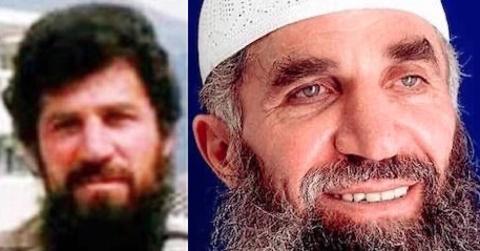Abd Al-Hadi Al-Iraqi is First “High-Value Detainee” To Accept Plea Deal at Guantánamo, Could Be Freed by 2024

Abd al-Hadi al-Iraqi, in a photo taken before his capture, and in recent years at Guantánamo.
If you can, please make a donation to support our work throughout the rest of 2022. If you can become a monthly sustainer, that will be particularly appreciated. Tick the box marked, "Make this a monthly donation," and insert the amount you wish to donate.
By Andy Worthington, June 30, 2022
Two weeks ago, a significant event took place at Guantánamo, when Abd al-Hadi al-Iraqi, a 60- or 61-year old "high-value detainee," whose real name is Nashwan al-Tamir, and who was one of the last prisoners to arrive at Guantánamo, in April 2007, admitted to being involved in war crimes in a plea deal that could see him released from the prison by 2024.
It is the first plea deal reached with a "high-value detainee" under President Biden, and may indicate a way forward for the other nine "high-value detainee" trials, including those of the five men accused of involvement in the 9/11 attacks, and of Abd al-Rahim al-Nashiri, accused of involvement in the attack, in 2000, on the USS Cole, in which 17 US Navy sailors were killed. The trials are stuck in seemingly endless pre-trial hearings, largely because of the seemingly unresolvable problem of providing fair trials to men who were tortured, and it is noteworthy that, in March, it was reported that plea deals were being discussed in connection with the 9/11 trial.
When al-Iraqi arrived at Guantánamo over 15 years ago, the Pentagon described him as "one of al-Qaeda's most senior and most experienced operatives," although details about how he ended up at Guantánamo were rather more shady. A Pentagon spokesman, Bryan Whitman, explained that he had been transferred to DoD custody from the custody of the CIA, although he "would not say where or when al-Iraqi was captured or by whom," while a U.S. intelligence official, "speaking on condition of anonymity because of the sensitivity of the matter," told the Associated Press that al-Iraqi had been captured in late 2006 "in an operation that involved many people in more than one country."
A month later, in an interview with Al-Jazeera, Mustafa Abu al-Yazid, a significant member of Al-Qaeda in Afghanistan, said that al-Iraqi had been en route to Iraq when he "was arrested in Turkey," and was then "handed over to the Americans," and it was later confirmed, in the Senate Intelligence Committee’s report about the CIA torture program, that he was held for six months in CIA custody, even though, in September 2006, when 14 "high-value detainees" were transferred to Guantánamo from CIA "black sites," President Bush, who had previously denied the existence of the "black sites," declared that, as a result of these transfers, the "black sites" had all been shut down.
As was also revealed in the torture report, al-Iraqi "was consistently assessed as being cooperative" while he was in CIA custody, although "interrogators believed he was withholding information" on future operations "and the locations of high-value targets." However, it was also revealed that, during February 2007, "CIA Headquarters discussed the possible use of 'enhanced interrogation techniques' [torture] against al-Iraqi, although by the end of the month they had determined that there was 'insufficient intelligence … that [al-Iraqi] possesse[d] actionable information … to justify the use' of EITs."
Charged and arraigned
When this information finally surfaced via the Senate torture report, al-Iraqi had already been in Guantánamo for seven and a half years, largely swallowed up in the secrecy that particularly enshrouded the "high-value detainees" — and particularly those who hadn’t been charged. This situation had only changed when he was charged in June 2013, and when a charge of conspiracy was added in February 2014. In June 2014, he was finally arraigned, with Carol Rosenberg, then working for the Miami Herald, reporting that he "looked significantly older than his pre-capture photo," and explaining that he was accused of "classic war crimes punishable by life in prison" — specifically, "targeting medical workers and civilians as well as foreign troops in Afghanistan" — in 2003 and 2004.
As I explained at the time, al-Iraqi’s defense team highlighted the problems raised by the fact that the U.S. authorities seemed to regard him as being involved with both al-Qaeda and the Taliban. As one of his attorneys, Army Lt. Col. Chris Callen said, "If you would say he’s Taliban, we would argue he’s a lawful combatant." He added, "It seems at the start of the war they conflated the two," then adopted a policy of "pick one."
Al-Iraqi’s lawyers also explained that he was "originally from Mosul, although he has a wife and children in Afghanistan," and described him as "a courteous former non-commissioned officer in the Iraqi Army who handled logistics and administrative functions during the 1980-88 Iran-Iraq war," and who then "fled his homeland for a new life in Afghanistan after Saddam Hussein’s invasion of Kuwait, and before the U.S.-led Operation Desert Storm."
They added, as I described it, that "he hasn’t taken part in hunger strikes, is a pious Muslim, and has read everything in the library in the secretive Camp 7, where the 'high-value detainees' are held." They also described him as "more like a Taliban soldier than a terrorist."
A degenerative spinal condition
Since then, al-Iraqi’s pre-trial hearings have largely been dominated by his severe physical problems. As Middle East Eye explained in an article last September, when he had "had a medical emergency," he was "reported to have lost feeling in his lower legs," and was "not able to walk or stand," because he "has a degenerative spinal condition, and is among the most physically disabled" of the remaining 36 prisoners.
As the Center for Victims of Torture explained, al-Iraqi "was diagnosed with spinal stenosis in September 2010," although "he did not receive surgical treatment until his condition became severe seven years later, when he 'began to experience a significant loss of sensation in both of his feet and a loss of bladder control.'" He subsequently "received four additional surgeries performed at Guantánamo by off-island specialists" (because of a persistent ban in the annual National Defense Authorization Act on transferring Guantánamo prisoners to the U.S. mainland for any reason, even for urgent medical care), and it was also noted that he "continues to suffer from the condition and may require additional surgery."
It was also noted that al-Iraqi "relies on a wheelchair and walker inside the prison," and "also has a padded geriatric chair and a hospital bed for court, the latter of which is kept for when heavy painkillers cause him to fall asleep."
The plea deal
At his plea hearing on June 13, as Carol Rosenberg reported for the New York Times, al-Iraqi "spent much of the daylong hearing responding, 'Yes, your honor,' to the questions of the military judge, Lt. Col. Mark F. Rosenow, about a secret account of his activities in Afghanistan as a co-conspirator with Osama bin Laden and other top Qaeda leaders between 1996 and 2003," which "included more than 100 items." The charge sheet is here.
Rosenberg added that al-Iraqi "pleaded guilty to the traditional war crimes of attacking protected property — a U.S. military medevac helicopter that insurgents who answered to him failed to shoot down in Afghanistan in 2003 — and of treachery and conspiracy connected to insurgent bombings that killed at least three allied troops, one each from Canada, Britain and Germany."
As Judge Rosenow described it, "Those allied soldiers were killed by car bombs or suicide bombers posing as civilians … If Mr. Hadi had known in advance about the plans, he had a duty to stop them. If he had possessed no prior knowledge, [he] had a duty to punish the perpetrators."
Rosenberg stressed that the plea deal represented "a drastic scaling back" of the government’s initial charges against him, when it was claimed that he "was part of the sweeping Qaeda conspiracy to rid the Arabian Peninsula of non-Muslims," that he had knowledge of the 9/11 attacks, and was involved in "the destruction by the Taliban of monumental Buddha statues in Afghanistan’s Bamiyan Valley, a UNESCO World Heritage site, in March 2001," and "the 2003 assassination by insurgents of a French worker for the United Nations relief agency." The disappearance of all of the above rather tends to reinforce suspicions that this was unreliable information extracted from al-Iraqi while he was in a CIA "black site," although it could also have been extracted in dubious circumstances via his fellow prisoners.
Under the plea agreement, as Rosenberg also explained, "a military jury will hear the evidence against him," and will be asked to choose a sentence "within a range of 25 to 30 years." After this, the military commissions’ Convening Authority, a "senior Pentagon official responsible for overseeing" the commissions, "will reduce it to 10 years."
Also under the agreement, sentencing is postponed for two years, to allow the U.S. government "to find a sympathetic nation to receive him and provide him with lifelong medical care," and also to hold him while he serves out the rest of his sentence. As Susan Hensler, his Pentagon-appointed civilian attorney, explained, "He pleaded guilty for his role as a frontline commander in Afghanistan. He has been in custody for 16 years, including the six months he spent in a CIA black site. We hope the United States makes good on its promise to transfer him as soon as possible for the medical care he desperately needs."




